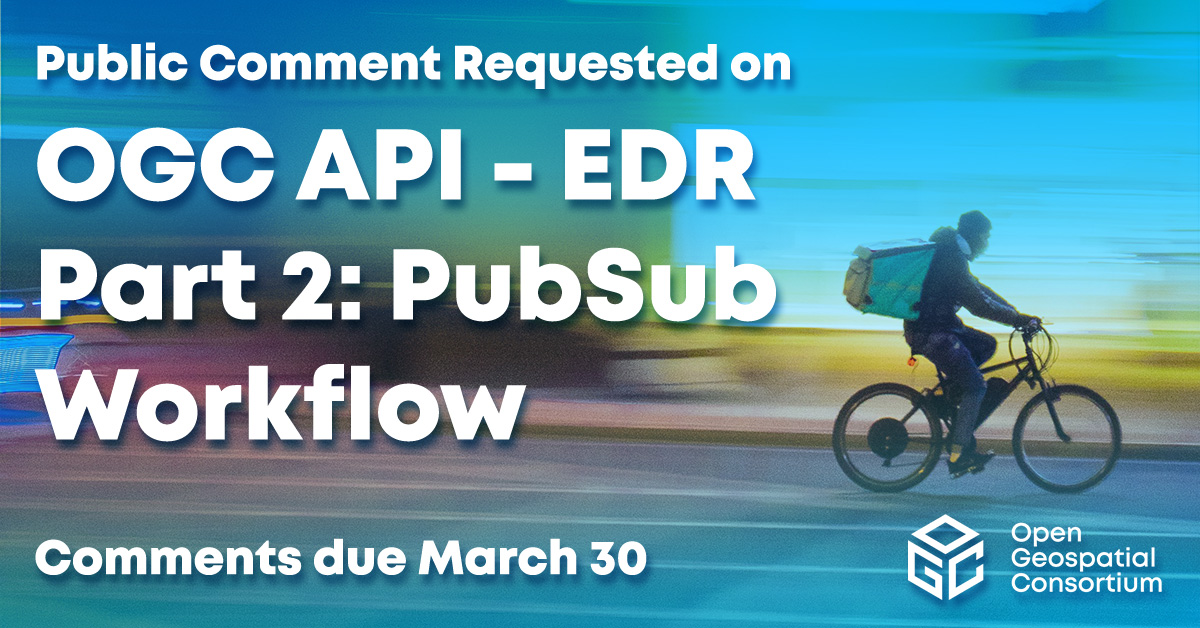Request Closed: February 29, 2024 9:00 am — March 30, 2024 11:59 pm (AoE)
The Open Geospatial Consortium (OGC) seeks public comment on the OGC API – Environmental Data Retrieval – Part 2: Publish-Subscribe Workflow (OGC API – EDR – Part 2) candidate Standard before its adoption. Comments are due by March 30, 2024.
The goal of the Standard is to provide a basis for Publish-Subscribe implementation patterns within the OGC API ecosystem. As such, the candidate OGC API – EDR - Part 2 Standard defines:
- Requirements for Publish-Subscribe patterns specific to event-driven data workflows and
- Options for realizing Publish-Subscribe workflows in implementations of OGC API Standards.
OGC API Standards define Web-based capabilities that are typically based on polling for collection resource updates (new features, records, items, coverages, maps, etc.). Depending on a collection’s temporal resolution or frequency of updates, an event-driven “Publish-Subscribe” architecture provides a timely, efficient, and low latency approach for the notification or delivery of data updates. For example, consider the dissemination of real-time weather alerts; timing and delivery of these data are critical to health and safety, where no time can be lost in notifying the public of such events. The candidate OGC API – EDR - Part 2 Standard therefore provides recommendations on applying Publish-Subscribe architectural patterns to implementations of OGC API – EDR. These recommendations may also be fit for purpose across additional APIs as part of future specification developments.
OGC API – EDR - Part 2 achieves this by defining building blocks that can be assembled to implement Publish-Subscribe workflows (including discovery, topic structure, and encoding) as part of OGC API - Environmental Data Retrieval - Part 1: Core. A topic structure is the structured information that a publisher makes available to allow subscribers to choose information of interest to them.
The Standard defines a discovery capability that contains a topic structure in support of binding to notifications for data access and retrieval. It also defines a baseline message payload that can contain summary descriptive information in GeoJSON about a given notification for new data events (new granule, new model run, etc.).
For example, a user may be awaiting the release of a large new dataset. By subscribing to an appropriate information channel supplied by the data provider, the user will receive a notification when the dataset is published and can easily retrieve the data using an OGC API, such as OGC API – EDR or OGC API – Features. In cases where the data is relatively small, the notification message itself can contain the data of interest.
The OGC API – EDR - Part 2 Standard is based on the draft OGC Publish-Subscribe White Paper (OGC 20-081), as well as the Discussion paper for Publish-Subscribe workflow in OGC APIs (OGC 23-013).
To learn more about how the family of OGC API Standards work together to provide modular “building blocks for location” that address both simple and the most complex use-cases, visit ogcapi.org.
OGC Members interested in staying up to date on the progress of this standard, or contributing to its development, are encouraged to join the OGC Environmental Data Retrieval API Standards Working Group via the OGC Portal. Non-OGC members who would like to know more about participating in this SWG are encouraged to contact the OGC Standards Program.
The candidate OGC API – Environmental Data Retrieval – Part 2: Publish-Subscribe Workflow Standard (OGC 23-057r1) (.HTML) is available for review and comment on the OGC Portal. Comments are due by March 30, 2024, and should be submitted via the method below.
To Comment:
Comments can be submitted as an issue on the OGC API – Environmental Data Retrieval GitHub repository for a period ending on the “Close request date” listed above. Comments received will be consolidated and reviewed by OGC members for incorporation into the document.
